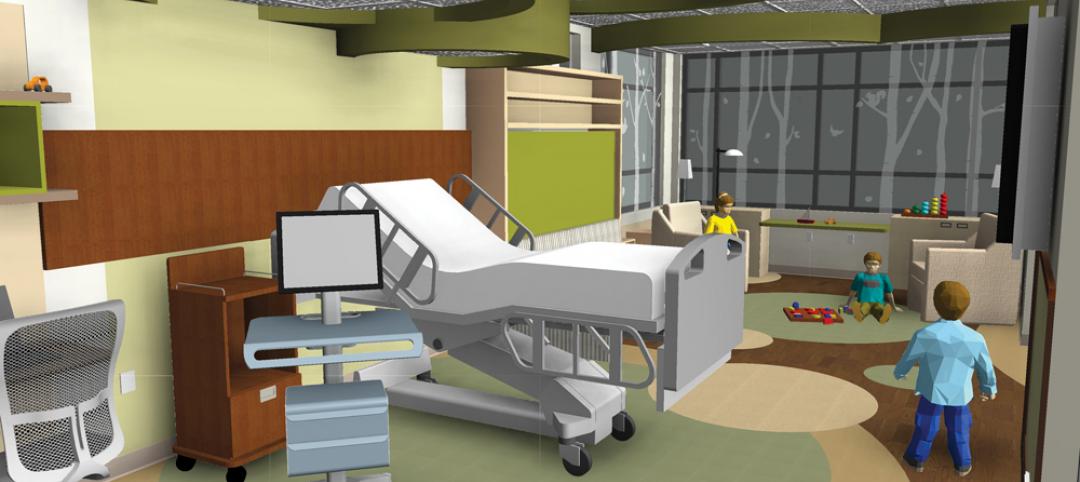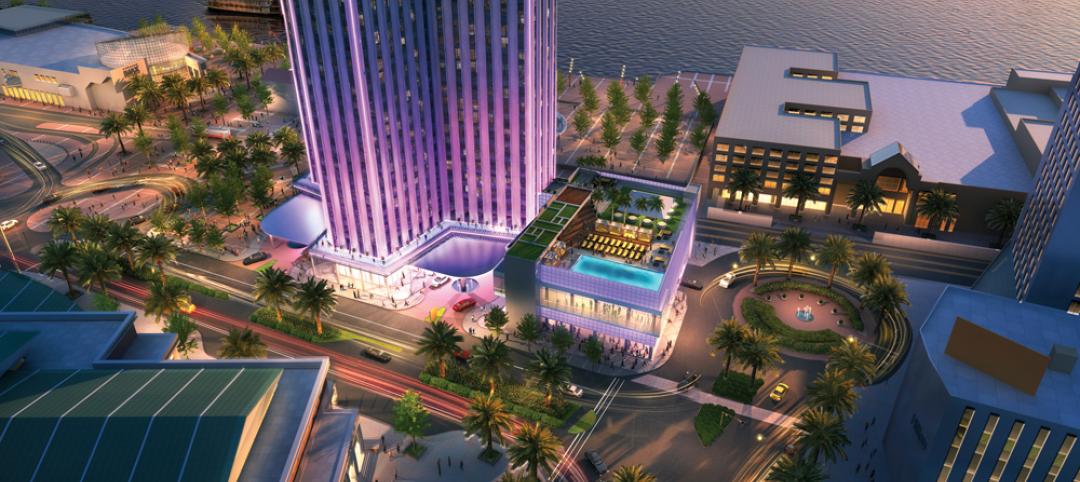
Built in 1928 as a shining Art Deco beacon for the upper Midwest, the Sears building in Minneapolis—with its 16-story central tower, department store, catalog center, and warehouse—served customers throughout the Twin Cities area for more than 65 years.
 |
| The Main Street connects Midtown Exchange’s various parts: retail, office, residential, and hospitality. The mosaic sculptures by artist Lori Greene, part of a trio called “Divination Systems,” were commissioned for the project as part of a public art program. Greene is one of nine local artists whose works are installed throughout the building. ALL PHOTOS: PERZEL PHOTOGRAPHY GROUP |
But as nearby neighborhoods deteriorated and the catalog operation was shut down, by 1994 the once-grand structure was reduced to an empty shell, its windows broken and patched with plywood, its façade obscured behind chain-link fencing, its parking lot a haven for drug dealers.
Several proposals to raze the building and redevelop the area went unrealized, but in the late 1990s, things began to look up. A new wave of immigrating Hispanic and Somali families began to populate the surrounding Midtown neighborhood, opening restaurants and businesses and raising property values. The city installed a cycling and walking path, and greater public attention came to be focused on this huge, ungainly white elephant. Five years ago, the city acquired the site and launched a concerted effort to revitalize this once-grand landmark.
The 1928 Sears building encompassed a staggering 950,000 sf, larger than any of the modern skyscrapers in downtown Minneapolis. Finding a use for all that space was a major concern for the Minneapolis Community Department of Planning and Economic Development and the Midtown Community Works Partnership, the two organizations that took the lead in the redevelopment.
Their goal was to nurture a development program that would address several community issues: job creation, public safety, parking, and improved neighborhood services and infrastructure. Equally important was for any future development to respect the history and diversity of the Midtown neighborhood.
The city's RFP went out in 2003. The winning master plan, by Ryan Companies US, was ambitious, to say the least. Ryan proposed to turn the decayed hulk into a vibrant living-working-shopping environment that would encompass market-rate and affordable apartments, luxury condominiums, townhouses, a public marketplace, retail space, office suites, a 136-room hotel, and a new city bus transit center.
 |
| Midtown Exchange has 360 residential units consisting of apartments, townhouses, and condominiums, including luxury penthouses. The tower unit (left) is housed in space formerly occupied by a large water storage tank that was connected to the building’s original sprinkler system (right). |
Altogether, the three blocks of the Sears complex would form a true neighborhood hub that would honor the area's history and support long-term development, without the usual gentrification that often accompanies such upgrading projects.
The Ryan team, led by senior project manager Mike Ernst, had a nickname for the overall concept. They called it the B.H.A.G.—the Big Hairy Audacious Goal.
Construction complexity
A historic renovation, multiple owners, multiple uses, and a $122 million budget for reconstruction—construction projects don't get much more complicated than that. In mid-2004, Ryan's design-build team began managing more than 750 construction personnel on site. Many of the construction challenges arose from the many uses that would be located in one building, each with different space needs and systems requirements. Adding to the complexity of the Midtown Exchange renovation was the Sears building's age.
Historic restoration regulations prevented the Building Team from punching through outside walls to install new mechanical systems. The roof seemed the obvious answer, but was too weak to support the load. Structural engineer Collaborative Design Group had to pinpoint the flimsy parts of the roof, take them apart, and then strengthen and rebuild them.
 |
| During renovation, the exterior of the original 1928 Sears building was cleaned up and repaired but wasn’t radically altered. The cross section illustrates Midtown Exchange’s various uses. |
The roof was only the beginning of the structural problems. Going in, Ryan Companies had estimated that 25% of the building's rough structure would have to be reinforced and repaired. Surprise, surprise! It turned out to be closer to 80%. Ditto for the interior spaces, which had far more environmental problems than the team had estimated, with many floors literally coated with a loose layer of contaminated ash, chipped lead paint, and asbestos.
The very complexity of the project inspired the Building Team to find innovative solutions. They brought the rainwater runoff system up to code with a system of underground ponds, which created the needed stormwater retention without taking up usable space within the site.
Another solution came from outer space. In order to add a glass block floor to the building's south light well, the team had to install a fire door. To fit the area, however, the door had to be horizontal. After extensive research, they found a horizontal fire door—like that used in the construction of NASA's space shuttles—which fit their needs perfectly.
When the Sears building reopened as the Midtown Exchange earlier this year, it was a hit from the start. The lobby, restored to its original glory with marble floors, plaster coves, and wood paneling, was the jumping off point to a community center that employed more than 2,000 people. In fact, the largest employer, Allina Hospitals and Clinics, had leased all of the Exchange's 411,000 sf of office space.
Housing was another triumph. Nearly half the building is residential, with 219 apartments (80% affordable, 20% market rate), 52 townhouses, and 89 condos, including luxury penthouses with two-story, floor-to-ceiling windows.
Then there's the Midtown Global Market, a 72,500-sf retail center with 62 ethnic food vendors offering organic produce, fresh fish, tamales, Caribbean food, Mideast buffet, Scandinavian sandwiches, and Mexican pastries. Even though the market just opened this past June, it is rapidly becoming one of the Twin Cities' hottest dining and shopping destinations.
Even more ambitious than the construction program itself was Ryan's effort at community involvement, which took in housing groups (Project for Pride in Living, Habitat for Humanity), the city's Neighborhood Development Center (in partnership with the Latino Economic Development Center and the African Development Center), the Association of Women Contractors, and the National Association of Minority Contractors, whose Upper Midwest Chapter named Ryan Companies “For-Profit Affiliate of the Year” in 2004 and 2005.
“This was a heroic project with huge social impact,” said awards judge Robert Selby, FAIA. “It removed an eyesore and created new environments and new jobs.”
Related Stories
| Nov 18, 2013
6 checkpoints when designing a pediatric healthcare unit
As more time and money is devoted to neonatal and pediatric research, evidence-based design is playing an increasingly crucial role in the development of healthcare facilities for children. Here are six important factors AEC firms should consider when designing pediatric healthcare facilities.
| Nov 15, 2013
Greenbuild 2013 Report - BD+C Exclusive
The BD+C editorial team brings you this special report on the latest green building trends across nine key market sectors.
| Nov 15, 2013
Pedia-Pod: A state-of-the-art pediatric building module
This demonstration pediatric treatment building module is “kid-friendly,” offering a unique and cheerful environment where a child can feel most comfortable.
| Nov 13, 2013
Installed capacity of geothermal heat pumps to grow by 150% by 2020, says study
The worldwide installed capacity of GHP systems will reach 127.4 gigawatts-thermal over the next seven years, growth of nearly 150%, according to a recent report from Navigant Research.
| Nov 8, 2013
Oversized healthcare: How did we get here and how do we right-size?
Healthcare facilities, especially our nation's hospitals, have steadily become larger over the past couple of decades. The growth has occurred despite stabilization, and in some markets, a decline in inpatient utilization.
| Nov 6, 2013
Green hotel trends: Industry expands its sustainability focus beyond laundry
There’s more to creating a sustainable hotel than saving water and power by asking guests to reuse their towels.
| Oct 30, 2013
15 stellar historic preservation, adaptive reuse, and renovation projects
The winners of the 2013 Reconstruction Awards showcase the best work of distinguished Building Teams, encompassing historic preservation, adaptive reuse, and renovations and additions.
| Oct 30, 2013
11 hot BIM/VDC topics for 2013
If you like to geek out on building information modeling and virtual design and construction, you should enjoy this overview of the top BIM/VDC topics.
| Oct 28, 2013
Urban growth doesn’t have to destroy nature—it can work with it
Our collective desire to live in cities has never been stronger. According to the World Health Organization, 60% of the world’s population will live in a city by 2030. As urban populations swell, what people demand from their cities is evolving.
| Oct 18, 2013
Researchers discover tension-fusing properties of metal
When a group of MIT researchers recently discovered that stress can cause metal alloy to fuse rather than break apart, they assumed it must be a mistake. It wasn't. The surprising finding could lead to self-healing materials that repair early damage before it has a chance to spread.
















